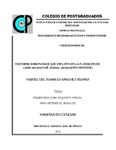Factores ambientales que influyen en la floración de Laelia anceps Lindl subesp anceps (ORCHIDACEAE).
Abstract
Este estudio tuvo como objetivo evaluar el efecto de la fuente de luz en la inducción y calidad floral así como en la concentración de reguladores de crecimiento y nutrimentos en L. anceps subesp. anceps con fotoperíodos de 9 y 12 h y temperatura nocturna de 13 y 17oC. Se emplearon plantas adultas y lámparas fluorescentes combinadas con lámparas de aditivos metálicos y lámparas de alta presión de sodio con flujo de fotones fotosintéticos (FFF) de 80 µmol m-2 s-1 (FL1) y lámparas LEDs con FFF de 64 µmol m-2 s-1 (FL2). Con fotoperíodo de 9 h y 13°C, la condición de floración previa (CFP) tuvo efecto en el porcentaje de inducción floral y las fuentes de luz efecto diferencial en la concentración de reguladores y nutrimentos, efecto dependiente del órgano vegetal. Con fotoperíodo de 9 h y 17°C, la fuente de luz tuvo efecto en el diámetro del pseudobulbo de los brotes no inducidos a floración y efecto diferencial en la concentración de reguladores y nutrimentos en planta. Con fotoperíodo de 12 h y 13 °C la fuente de luz tuvo efecto en el tamaño del brote no inducido y efecto diferencial en la concentración de reguladores y de nutrimentos. Con fotoperíodo de 12 h y 17 °C la fuente de luz no tuvo efecto en el crecimiento vegetativo ni en el porcentaje de inducción a floración pero sí en el tamaño del brote inducido y en la concentración de reguladores y nutrimentos. En general con FL1 se tuvo alto porcentaje de inducción floral, menor número de días para antesis, mayor acumulación de AIA, AIB y BAP en raíz, pseudobulbo de la planta e inflorescencia del brote, pero menor concentración de N, P, K, S, Mg y Mn en hoja, pseudobulbo y raíz. Mientras que con FL2 se tuvo alta concentración de AIA y AIB en raíz, pseudobulbo del brote e inflorescencia; pero menor de K y Zn en hoja y pseudobulbo y de B en pseudobulbo. Lo anterior indica que la fuente de luz como factor ambiental no tiene efecto significativo en la inducción floral de la especie de orquídea en estudio. _______________ ENVIRONMENTAL FACTORS THAT AFFECT THE FLOWERING OF Laelia anceps Lindl. subsp. anceps (ORCHIDACEAE). ABSTRACT: The aim of this study was to evaluate the effect of a source of light in the induction and floral quality as well as the concentration of growth regulators and nutrients in L. anceps subsp. anceps with photoperiods of 9 and 12 h and night temperature of 13 and 17°C. Adult plants were used and fluorescent lamps combined with metallic-additive lamps and high pressure sodium lamp with photosynthetic photon flux (FFF) of 80 µmol m-2 s-1 (FL1) and LED lamps with FFF of 64 µmol m-2 s-1 (FL2). The prior flowering condition (CFP) with photoperiod of 9 h at 13°C showed effect on the % of flowering induction and the light sources showed differential effect on the concentration of growth regulators and nutrients, the effect depended on the vegetative organ. On the other hand, when using a photoperiod of 9h at 17°C, the light source had an effect on the pseudo bulb diameter of the buds not induced to flowering and showed a differential effect on the concentration of growth regulators and nutrients in the plant. The light source with photoperiod of 12 h at 13°C affected the size of the bud not induced to flowering and showed a differential effect on the concentration of growth regulators and nutrients. The light source with photoperiod of 12 h and 17°C showed no effect in the vegetative growth nor in the % of flowering induction; however, it showed effect on the size of the bud induced to flowering and the concentration of growth regulators and nutrients. In general, by using FL1, the highest % of flowering induction was observed, as well as a lower number of days for anthesis, higher accumulation of AIA, AIB and BAP in the root, pseudobulb of the plant and bud inflorescence. On the other hand, lower levels of N, P, K, S, Mg, and Mn in the leaf, pseudo bulb and root were observed when using FL1. When using LF2, a higher concentration of AIA and AIB in the root, pseu dobulb and influorescence was observed, but lower concentration of K and Zn in the leaf and pseudo bulb as well as B in the pseudo bulb. All of the above indicates that the light source is an environmental factor that not affects the flowering of the orchid specie studied.
Collections
- Tesis MC, MT, MP y DC [131]


